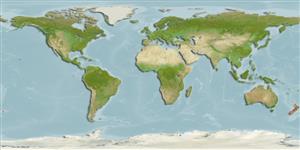Teleostei (teleosts) >
Anguilliformes (Eels and morays) >
Anguillidae (Freshwater eels)
Etymology: Anguilla: Latin, anguilla, .-ae = eel (Ref. 45335).
Eponymy: Dr Johann Karl Ernst Dieffenbach (1811–1855) was a German physician, naturalist, explorer, linguist and writer. [...] (Ref. 128868), visit book page.
More on author: Gray.
Environment: milieu / climate zone / depth range / distribution range
Ecology
Marine; freshwater; brackish; demersal; catadromous (Ref. 51243). Subtropical; 34°S - 47°S
Southwest Pacific: endemic to New Zealand.
Length at first maturity / Size / Weight / Age
Maturity: Lm ?, range 80 - ? cm
Max length : 185 cm TL male/unsexed; (Ref. 44724); 156.0 cm TL (female); common length : 60.0 cm TL male/unsexed; (Ref. 9258); common length :100 cm TL (female); max. published weight: 25.0 kg (Ref. 11115)
Commonly found in lakes and rivers (Ref. 9258). Inhabits stony rivers (Ref. 9072). Migrates to the sea to breed. Oviparous (Ref. 205). Marketed fresh, smoked and frozen; eaten fried and broiled (Ref. 9988). Reports of reaching up to 2 meters and 50 kilograms are rare and more common historically; in recent times, only a few exceed 120 cm TL (Ref. 82796).
Life cycle and mating behavior
Maturity | Reproduction | Spawning | Eggs | Fecundity | Larvae
Armitage, R.O., D.A. Payne, G.J. Lockley, H.M. Currie, R.L. Colban, B.G. Lamb and L.J. Paul (eds.), 1994. Guide book to New Zealand commercial fish species. Revised edition. New Zealand Fishing Industry Board, Wellington, New Zealand, 216 p. (Ref. 9258)
IUCN Red List Status (Ref. 130435: Version 2024-2)
Threat to humans
Harmless
Human uses
Fisheries: commercial; aquaculture: experimental
Tools
Special reports
Download XML
Internet sources
Estimates based on models
Preferred temperature (Ref.
123201): 10.6 - 18.3, mean 15.1 °C (based on 138 cells).
Phylogenetic diversity index (Ref.
82804): PD
50 = 0.5000 [Uniqueness, from 0.5 = low to 2.0 = high].
Bayesian length-weight: a=0.00093 (0.00076 - 0.00115), b=3.20 (3.15 - 3.25), in cm total length, based on LWR estimates for this species (Ref.
93245).
Trophic level (Ref.
69278): 4.5 ±0.5 se; based on diet studies.
Resilience (Ref.
120179): Very Low, minimum population doubling time more than 14 years (Tmax=60; tm=10-48 years based on age-length relationship.).
Fishing Vulnerability (Ref.
59153): Very high vulnerability (90 of 100).
